
The Palazzo Ducale di Mantova is a group of buildings in Mantua, Lombardy, northern Italy, built between the 14th and the 17th century mainly by the noble family of Gonzaga as their royal residence in the capital of their Duchy. The buildings are connected by corridors and galleries and are enriched by inner courts and wide gardens. The complex includes some 500 rooms and occupies an area of c. 34,000 m2, which make it the sixth largest palace in Europe after the palaces of the Vatican, the Louvre Palace, the Palace of Versailles, the Royal Palace of Caserta and the Castle of Fontainebleau. It has more than 500 rooms and contains seven gardens and eight courtyards. Although most famous for Mantegna's frescos in the Camera degli Sposi, they have many other very significant architectural and painted elements.

Guglielmo Embriaco, was a Genoese merchant and military leader who came to the assistance of the Crusader States in the aftermath of the First Crusade. Embriaco is considered one of the founders of what would become the Republic of Genoa.

Palazzo Bianco is one of the main buildings of the center of Genoa, Italy. It is situated at 11, via Garibaldi.

The Embriaco family were a prominent Genoese family, who played an important role in the history of the Crusader states. It also gave consuls, admirals and ambassadors to the Republic of Genoa.

The Palazzo San Giorgio or Palace of St. George is one of the most important and well-known historic buildings in Genoa. It currently houses the headquarters of the Port System Authority of the Western Ligurian Sea.

The Palazzo Brignole Sale or Palazzo Rosso is a house museum located in Via Garibaldi, in the historical center of Genoa, in Northwestern Italy. The palace is part of the UNESCO World Heritage Site Genoa: Le Strade Nuove and the system of the Palazzi dei Rolli. The rich art collection inside, along with the galleries of Palazzo Bianco and Palazzo Doria Tursi, is part of the Musei di Strada Nuova and consists of the works of artists of the caliber of Antoon van Dyck, Guido Reni, Paolo Veronese, Guercino, Gregorio De Ferrari, Albrecht Dürer, Bernardo Strozzi and Mattia Preti.

Santa Maria di Castello is a church and religious complex in Genoa, Italy. Administrated for a long time by the Dominicans, it is located in the Castello hill of the city, where in the Middle Ages a bishop's fortified castle existed. The church is flanked by the large Tower of the Embriaci.

The walls of Genoa constitute in their whole the several circles of walls that protected and defended the city of Genoa, former capital of the homonymous republic. To this day, large portions of these walls remain, and Genoa has more and longer walls than any other city in Italy.
Giuseppe Maria Brignole-Sale (1703–1769) was a Genoese nobleman and father of Maria Caterina Brignole, Princess of Monaco and later Princess of Condé. He was the 7th Marquess of Groppoli. The reigning Albert II of Monaco is a direct descendant.

Genoa is a city in and the capital of the Italian region of Liguria, and the sixth-largest city in Italy. In 2023, 558,745 people lived within the city's administrative limits. While its metropolitan city has 813,626 inhabitants, more than 1.5 million people live in the wider metropolitan area stretching along the Italian Riviera.

The Palazzo Angelo Giovanni Spinola is a palace located in Via Garibaldi, in the historical center of Genoa, in Northwestern Italy. It was one of the 163 Palazzi dei Rolli of Genoa, the selected private residences where the notable guests of the Republic of Genoa were hosted during State visits. On 13 luglio del 2006 it was included in the list of 42 palaces which now form the UNESCO World Heritage Site Genoa: Le Strade Nuove and the system of the Palazzi dei Rolli. Now owned by a bank, it is possible to visit the areas open to the public.
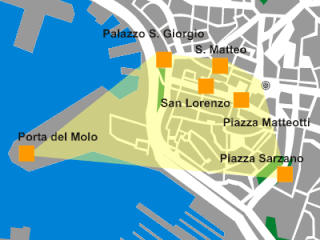
Molo is a neighbourhood in the old town of the Italian city of Genoa. It was one of the six sestieri of ancient Genoa. At present is part of the Genoa's city Municipio I.
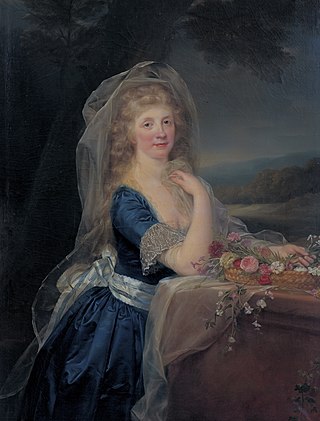
Anna Pieri Brignole-Sale (1765–1815) was a Sienese noble and court official. She was a supporter of the French Emperor Napoleon Bonaparte, and became a lady-in-waiting to his second wife, Marie Louise of Austria.

The Marquessate of Groppoli, in Tuscany and Liguria, was ruled by the House of Brignole-Sale, an illustrious patrician family of Genoa who were its sovereigns from 1592 to 1774.

Maria Brignole Sale De Ferrari, Duchess of Galliera was an Italian noblewoman and philanthropist. She enabled the foundation of the first museums in her birthplace of Genoa, the Palazzo Rosso and Palazzo Bianco as well as the Galliera Hospital and the San Filippo children's hospital. A statue of her by Giulio Monteverde stands in the hospital gardens.
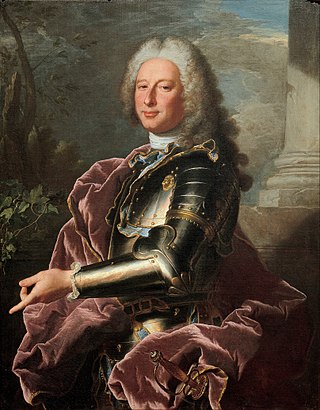
Giovanni Francesco II Brignole Sale, was the 158th Doge of the Republic of Genoa and the last king of Corsica.
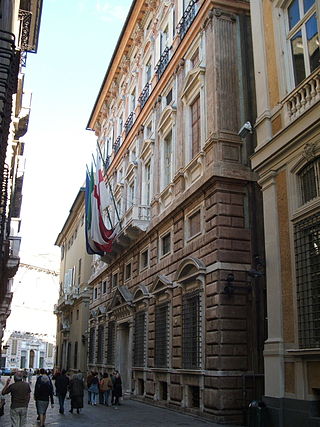
The Palazzo Carrega-Cataldi or Palazzo Tobia Pallavicino is a building located in via Garibaldi (Genoa) at number 4 in the historic centre of Genoa, included on 13 July 2006 in the list of the 42 palaces inscribed in the Rolli di Genova that became World Heritage by UNESCO on that date. The building is now the headquarters of Genoa's Chamber of Commerce.
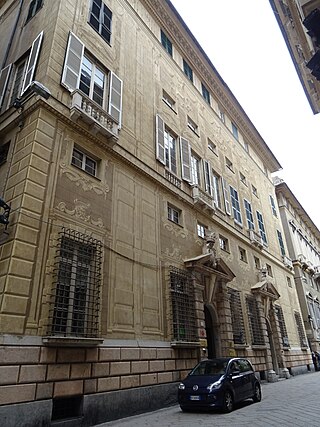
The palazzo Cattaneo-Adorno or palazzo Lazzaro e Giacomo Spinola is a building located on via Garibaldi, in the historical centre of Genoa, marked by house numbers 8 and 10, included on 13 July 2006 in the list of 42 palaces inscribed in the Rolli di Genova, which became World Heritage by UNESCO on that date. It houses a remarkable cycle of Baroque frescoes by Lazzaro Tavarone.
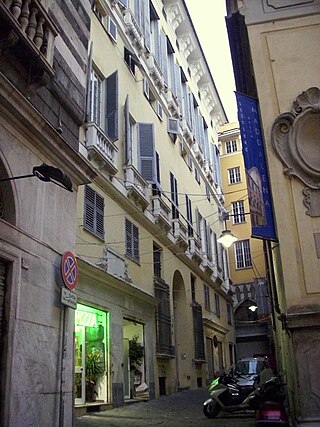
The palazzo Gio Battista Grimaldi is a building located in vico San Luca at no. 4 in the historical centre of Genoa, included on 13 July 2006 in the list of the 42 palaces inscribed in the Rolli di Genova that became World Heritage by UNESCO on that date.

The palazzo Belimbau, also known as palazzo Antoniotto Cattaneo or Palazzo Francesco De Ferrari, is a building located in Piazza della Nunziata at number 2 in Genoa, included on 13 July 2006 in the list of the 42 palaces inscribed in the Rolli di Genova that became World Heritage by UNESCO on that date.






















